When “Hot Dog” Isn’t Enough: the Chilean Completo
Chilean sandwiches tend toward excess. We’ve covered a few in our time here at the Tribunal, from the hot-and-cheesy Barros Jarpa and Barros Luco of the early days; the surprisingly good Chacarero with its unusual blend of tomatoes, chiles, and green beans; the meaty and stacked Churrasco sandwiches or the equally excessive Sánguche de Lomito; Chilean dining etiquette dictates that even sandwiches must be eaten with a knife and fork rather than one’s hands, and it shows.
It’s my understanding that an exception is made to the knife and fork rule for eating a hot dog in Chile. From what I’ve seen of those hot dogs though, they probably ought to be using the knife and fork anyway. The story goes that in the 1930s, a Chilean entrepreneur named Eduardo Bahamondes Muñoz decided to try selling hot dogs in Santiago after discovering them on a trip to New York. But when he started selling the sausages, potential patrons were put off by the meagerness of the offered condiments. Ketchup? Mustard? Muñoz had not counted on the inventiveness of the Chilean palate, but he quickly pivoted, adding a number of topping options. Some, like sauerkraut and the aforementioned ketchup and mustard, would not have looked out of place on a street vendor’s cart in the Big Apple. Others, like mayonnaise, were familiar but not commonly associated with hot dogs in the United States. Most importantly, he began using ingredients perhaps unknown in the northeastern US but beloved in Chile: palta, pebre, salsa Americana, salsa verde.
“Hot dog” no longer felt adequate to describe the sausage-inna-bun creations he was selling. He called this new type of hot dog “Completo,” as if to say that while 19th Century German immigrants in New York might have innovated the idea of selling Frankfurter sausages in a soft white bun, Chileans perfected it.
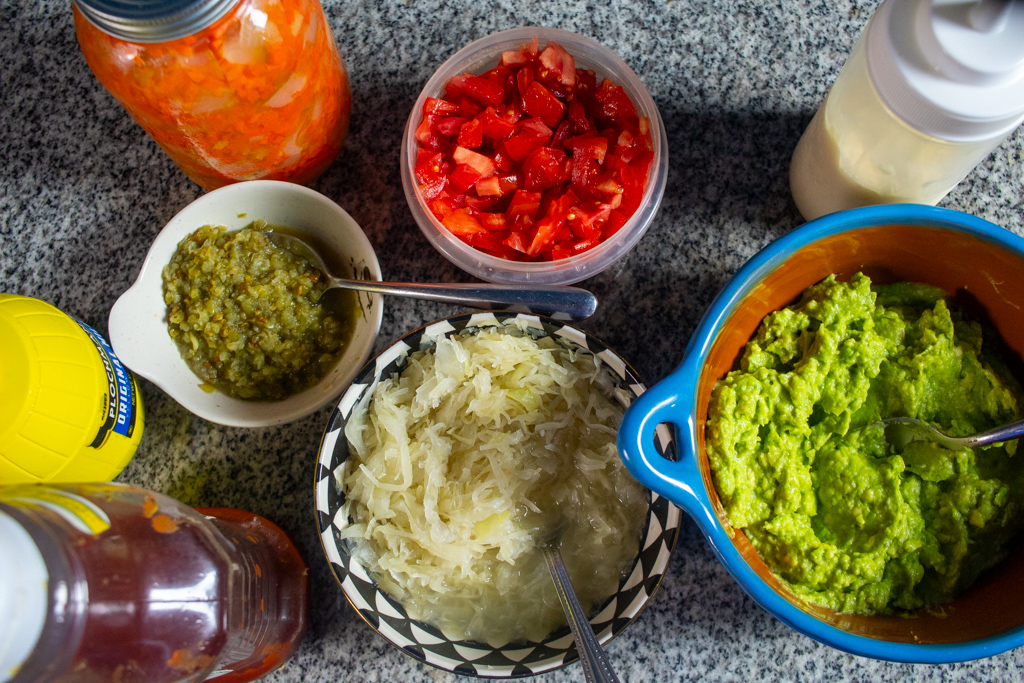
Palta in Chilean Spanish refers to avocado. In Chile, avocados are mashed and seasoned with a little salt, maybe a little oil, and that’s it–no lemon or lime juice, no tomatoes or chilies or onions are added, and the resulting mash is also simply called palta.
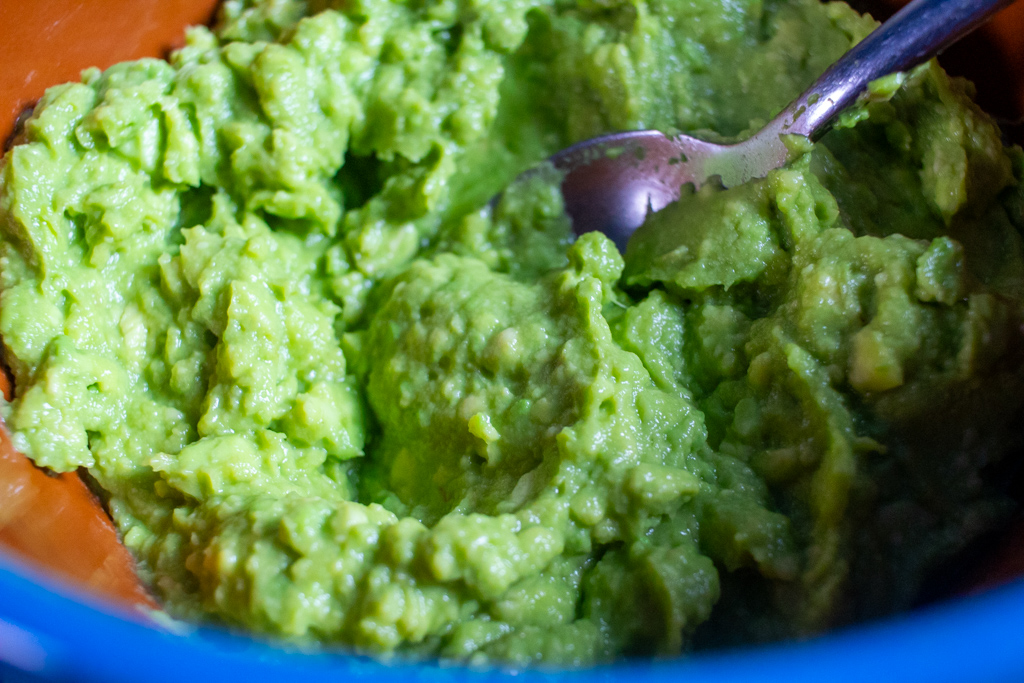
Thousands of German settlers immigrated to Chile between the late 19th Century and the early 20th, and around a million Chileans today still claim some amount of German lineage. A few still speak German today. So it’s not surprising that there was a market in Santiago for Frankfurter sausages in buns, nor that chucrut—sauerkraut–would be a popular topping for them.
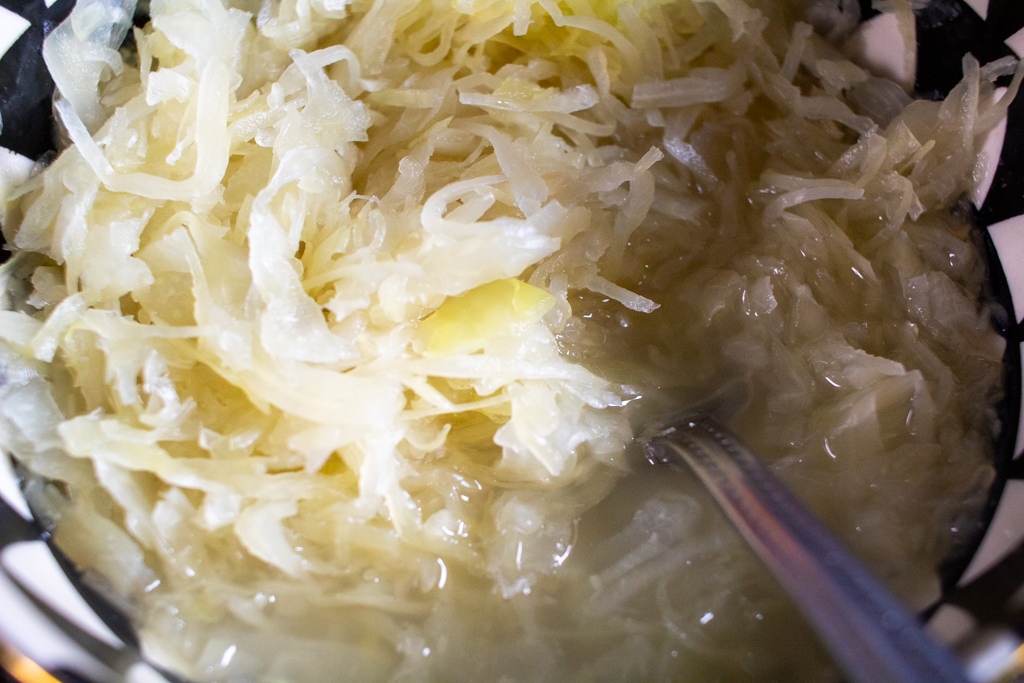
Salsa Americana is a Chilean take on pickle relish made with cucumbers, onions, and carrots that are briefly boiled to soften them, then pickled in a vinegar brine for a week or so before serving. The Chilean version of Salsa Americana–as there are other sauces in the Spanish-speaking world with the same name–is rarely mentioned outside of the context of the Chilean Completo, leading me to believe it was developed specifically for serving with sausages-inna-bun.
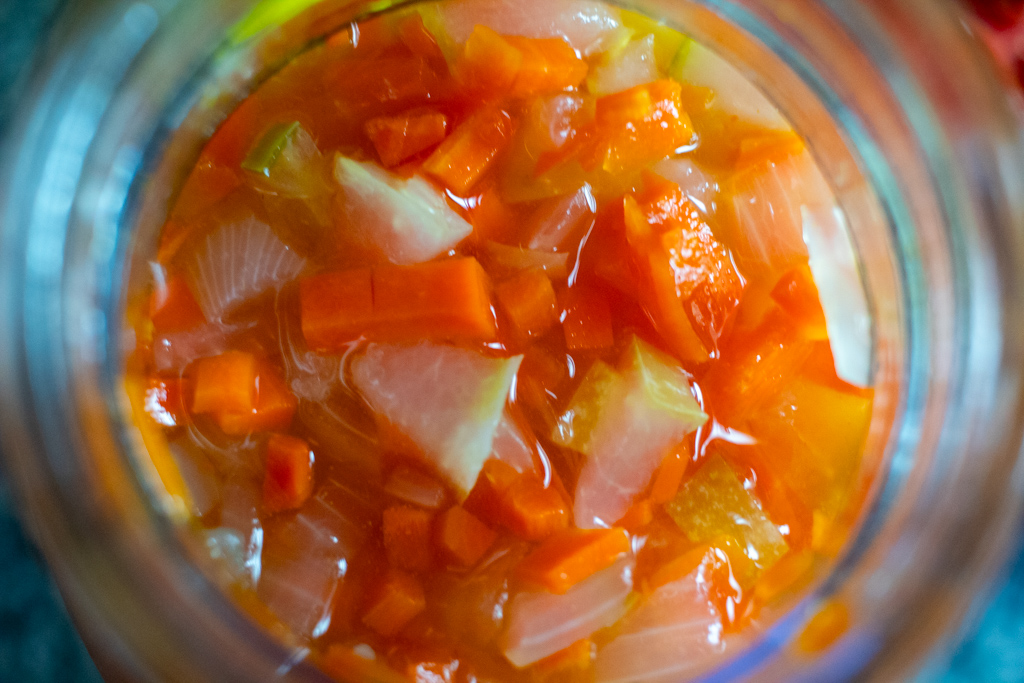
Salsa verde is another name that takes on many forms throughout the world, and has its own unique existence in Chilean cuisine. This salsa verde is a mix of minced parsley and onions with a little garlic, seasoned with salt and pepper and dressed with lemon juice or vinegar and oil.
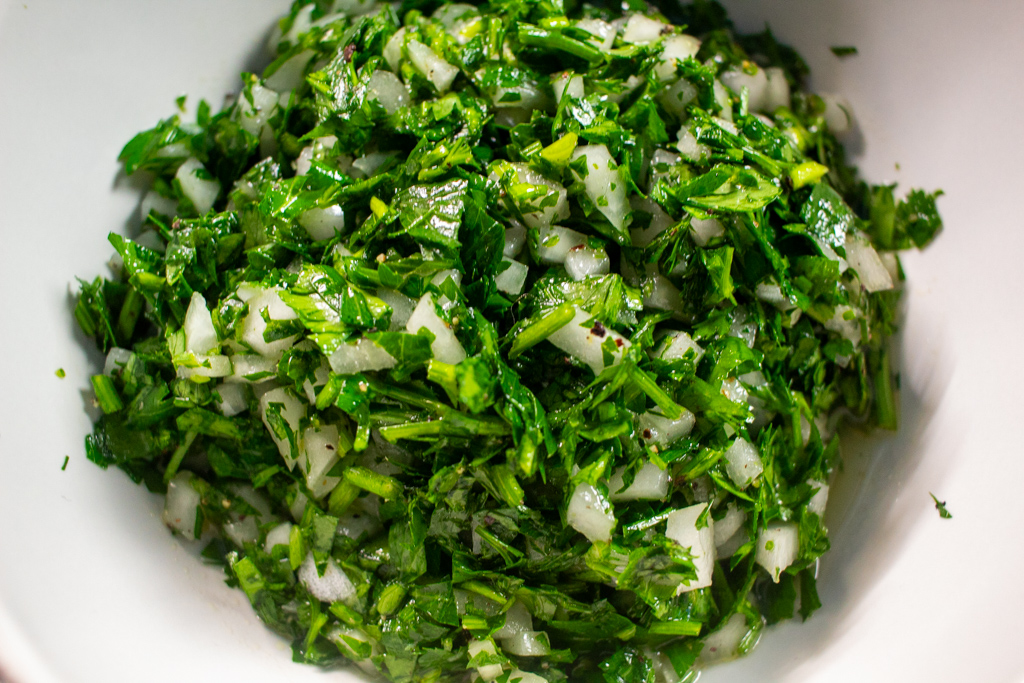
One source I read stated that Chilean salsa verde originated as a winter substitute for pebre, which in parts of Chile is a minced tomato salsa similar to Mexican pico de gallo (though in the north it is more of an herby hot sauce like Bolivian llajua.) In the winter, they claimed, when tomatoes were hard to find and parsley was a much move viable crop than cilantro, Chileans would make salsa verde instead. Yet tomatoes themselves–diced tomatoes rather than larger slices or wedges–are a universal ingredient in every type of Completo.

The only ingredients more vital to a Completo than the tomato are mayonesa–mayonnaise, of course, which Chileans slather copiously onto sandwiches in general, and which is used in prodigious amounts on the typical Completo–and the bun. Even the sausages themselves are optional, as the Completo falso consists of a bun stuffed with Completo toppings but no Frankfurters.

We won’t be making a Completo Falso. But it is worth noting that even among Completos, which are named in a way that indicates they are served “complete” or “with everything”–there is some variability in toppings, which different combinations named differently.
The Completo Italiano, named so because its colors recall those of the Italian flag, is made with a thick slathering of green palta, a thick white stripe of mayonesa, and a bright red layer of tomatoes. I may have, in fact, gotten those layers out of order in my version, but in many Completos toppings are not laid side-by-side but one above the other, with the sausage fully engulfed by both bread and condiments.
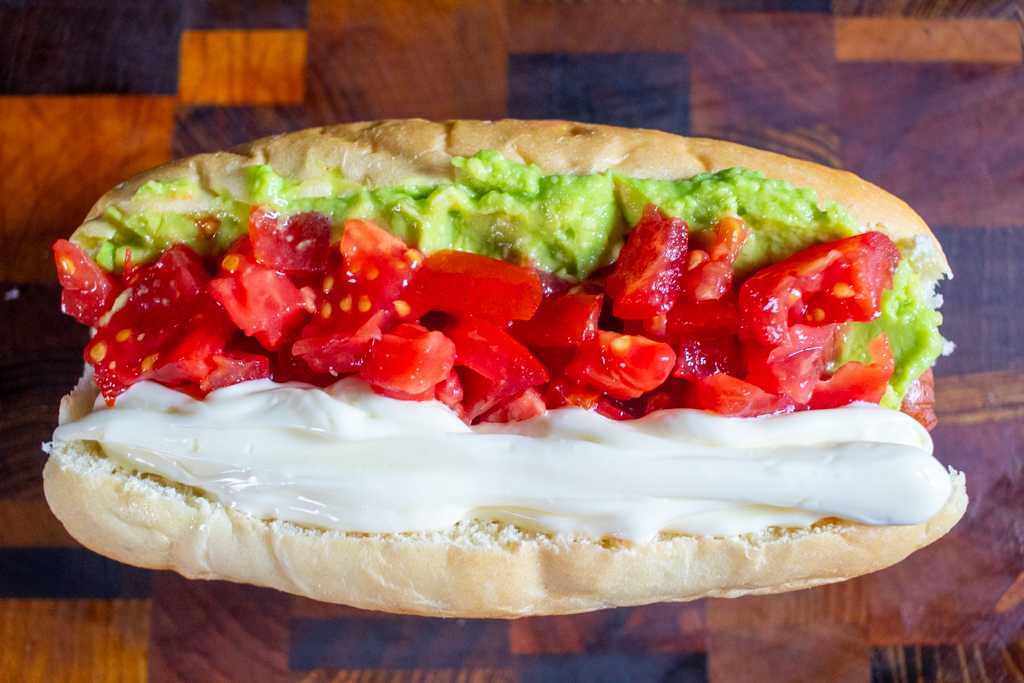
You can see just a little of my Frankfurter peeking out of the end there. That is not a given with the Completo. The Frankfurters they use may range from the standard 6 inches or so like I used here to massive footlongs or larger, and they are often served in even longer, larger buns to help contain the mass of toppings.
In any case, Italiano is a common set of toppings on many Chilean sandwiches, and for good reason–the combination just works. The sweetness and acidity of the tomatoes, salted just enough to help draw those flavors out more, is a natural partner for the rich fattiness of either mayonnaise or avocado, and serving both of them together simply amplifies the strengths of each. Three toppings, even in these proportions, is less excessive than some of the other Completo combinations, and balances well with the thicker, robustly-flavored Frankfurter-style sausage where something thinner or milder might get lost.
The Completo Alemán on the other hand, or German completo, is not named for the colors of the condiments but rather for the sauerkraut that anchors them. The sauerkraut is accompanied by the everpresent mayonnaise and tomato, and mustard, which is likely added at the table by the diner, seems like a no-brainer.

Of all the combinations I tried, this may have been my favorite, even without the mustard. I’m not sure why the idea of mayonnaise and sauerkraut together seems so odd to me, when America’s most well-known sauerkraut sandwich, the Reuben, features sauerkraut and either Russian dressing or Thousand Island, which are both mayonnaise-based sauces. The combination here is similar, a salty cured meat topped by deeply sour fermented funk of the kraut, dressed with a mayonnaise made more savory and sweet by the addition of tomato.
The most overloaded of the Completos will usually be called Completo Dinámico, combining salsa Americana, salsa verde, palta, and the requisite mayonnaise and tomato.
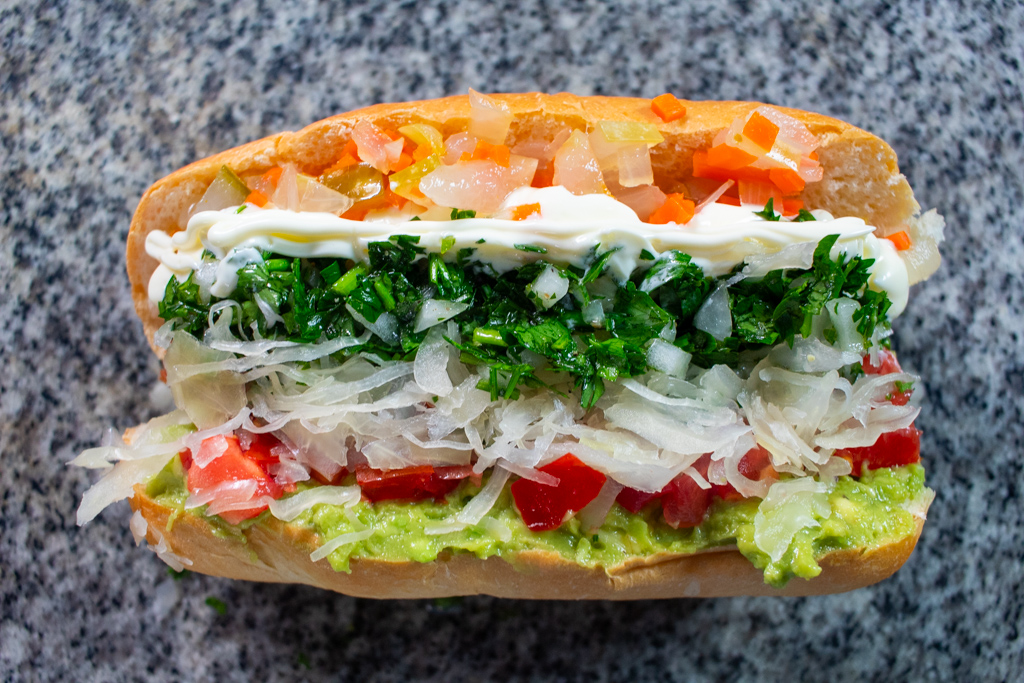
The Dinámico may be served with or without sauerkraut depending on the vendor.

There may be additional ingredients such as shoestring potatoes or pebre. Ketchup and mustard may be added or may simply be available for the diner to add for themself. There are probably topping options I’m missing, as Chile is a wonderland of wild and wacky sandwiches, and I don’t doubt that there is frequent innovation in the competitive Completosphere.
I’d try this again–and I hope to in Chile one day–but it seemed like too much to me. Chicago has a reputation for overloading its hot dogs, dragging them through the garden as the saying goes, but Chile has us beat by miles. There was a n thick, flavorful hot dog buried somewhere under all these toppings, all these flavors, the smooth and tongue-coating fattiness of the mayonnaise and avocado, the vinegar-sour of the pickled salsa Americana and the different, more bracing lactic sourness of the sauerkraut, the juicy-sweet tomatoes and the pungent, almost piny onion-and-parsley punch of the salsa verde–but by the time my mind processed all those other flavors, the small bit of sausage that came with them was gone.
More typically, a Completo will look something like this, and if one had to call it something, a Chilean might call it a Completo Completo.

The specifics of a Completo Completo may, again, differ from vendor to vendor. But this combination of salsa Americana with palta, mayonnaise, and tomatoes is a typical example. And I don’t feel like I need to eat every possible permutation of this sandwich to get the essence of it, nor do I necessarily need to try the massive arm-length versions available at some Chilean stands. I like hot dogs with sauerkraut. I like tomatoes and mayonnaise and avocado. The salsa Americana is terrific, and so is the salsa verde.
I like all these things in varying combinations, and even all at once though I find it a little overwhelming. Chilean sandwiches can be like that though.

I like sandwiches.
I like a lot of other things too but sandwiches are pretty great











That salsa verde looks incredible
I absolutely love the Completo and was turned onto this by my Chilean neighbors… but I’d also really like to see a post about the Italian Hot Dog sandwich only found in New Jersey. Many recipes show this being made with a regular hot dog bun or hoagie roll, but what makes it special is the pizza bread it is traditionally served on. Sadly, you can’t really replicate this sandwich unless you live in New Jersey and can get the pizza bread from an old school Italian bakery. I make sure to head to Dickie Dee’s or Jimmy Buff’s whenever I’m back East.